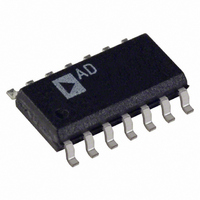SSM2166S Analog Devices Inc, SSM2166S Datasheet - Page 15

SSM2166S
Manufacturer Part Number
SSM2166S
Description
IC PREAMP AUDIO MONO MIC 14SOIC
Manufacturer
Analog Devices Inc
Datasheet
1.SSM2166SZ-REEL7.pdf
(20 pages)
Specifications of SSM2166S
Rohs Status
RoHS non-compliant
Output Type
1-Channel (Mono)
Voltage - Supply
4.5 V ~ 5.5 V
Features
Microphone
Mounting Type
Surface Mount
Package / Case
14-SOIC (3.9mm Width), 14-SOL
Max Output Power X Channels @ Load
-
Available stocks
Company
Part Number
Manufacturer
Quantity
Price
Part Number:
SSM2166SZ
Manufacturer:
ADI/亚德诺
Quantity:
20 000
Note that the SSM2166 processes the output of the buffer, which
in the previous example is 20 dB or 10 times the input level. Use
the oscilloscope to verify that the buffer is not being driven into
clipping with excessive input signals. In the application, take the
minimum gain in the buffer consistent with the average source
level as well as the crest factor (ratio of peak to rms).
EVALUATION BOARD SETUP PROCEDURE
When building a breadboard, keep the leads to Pin 3, Pin 4, and
Pin 5 short. An evaluation board is available from an Analog
Devices sales representative. The R and C designations refer to
the demonstration board schematic of Figure 26 and the parts
list in Table 7.
TEST EQUIPMENT SETUP
The recommended equipment and configuration are shown in
Figure 31. A low noise audio generator with a smooth output
adjustment range of 50 μV to 50 mV is a suitable signal source.
A 40 dB pad is useful to reduce the level of most generators by
100× to simulate the microphone levels. The input voltmeter
can be connected before the pad and need only go down to
10 mV. The output voltmeter should go up to 2 V. The oscilloscope
is used to verify that the output is sinusoidal and that no clipping
occurs in the buffer, and to set the limiting and noise gating
knees.
Step 1: Configure the Buffer
The SSM2166 has an input buffer that can be used when the
overall gain required exceeds 20 dB, the maximum user-selectable
gain of the VCA. In the example, the desired output is 500 mV
for an input of ~15 mV, requiring a total gain of 30 dB. Set the
buffer gain at 20 dB and adjust the VCA for 10 dB. In the socket
pins provided on the evaluation board, insert R1 = 100 kΩ and
R2 = 11 kΩ. The buffer gain is set to 20 dB (×10).
GENERATOR
VOLTMETER
500
SIGNAL
40
AC
0.1
GATE THRESHOLD
Figure 30. Transfer Characteristic
Figure 31. Test Equipment Setup
COMPRESSION
REGION
EVALUATION
1.0
SSM2166
BOARD
INPUT (mV)
ROTATION POINT
2
10
1
15
LIMITING REGION
OSCILLOSCOPE
VOLTMETER
AC
Rev. D | Page 15 of 20
Step 2: Initializing Potentiometers
With the power off, preset the potentiometers per Table 6.
Step 3: Testing Setup
With the power on, adjust the generator for an input level of
15 mV, 1 kHz. The output meter should indicate approximately
100 mV; if not, check the setup.
Step 4: Adjusting the Rotation Point
Set the input level to 15 mV and observe the output on the
oscilloscope. Adjust R3, ROTATION PT ADJ, until the output
level just begins to drop, then reverse so that the output is 500 mV.
The limiting has been set to 500 mV.
Step 5: Adjusting the VCA Gain
Set the input level to 15 mV. Adjust R10, GAIN ADJ, clockwise
(CW) for an output level of 500 mV. The VCA gain has been set
to 10 dB.
Step 6: Adjusting the Compression Ratio
Set the input signal for an output of 500 mV but not in limiting.
Note the value (around 15 mV). Next, reduce the input to 1/10
of the value noted (around 1.5 mV) for a change of −20 dB. Next,
adjust R6, COMP RATIO ADJ, CW until the output is 160 mV for
an output change of −10 dB. The compression, which is the
ratio of the output change to the input change, in decibels (dB),
has been set to 2:1.
Step 7: Setting the Noise Gate
With the input set at 100 μV, observe the output on the oscilloscope
and adjust R7, NOISE GATE ADJ, CCW until the output drops
rapidly. Rock the control back and forth to find the knee. The
noise gate has been set to 100 μV. The range of the noise gate is
from 0.3 mV to over 0.5 mV relative to the output of the buffer.
To fit this range to the application, it may be necessary to attenuate
the input or apportion the buffer gain and VCA gain differently.
Step 8: Listening
At this time, it may be desirable to connect an electret micro-
phone to the SSM2166 and listen to the results. Be sure to include
the proper power for the internal FET of the microphone
(usually 2 V dc to 5 V dc through a 2.2 kΩ resistor). Experiment
with the settings to hear how the results change. Varying the
averaging capacitor, C4, changes the attack and decay times,
which are best determined empirically. The compression ratio
keeps the output steady over a range of microphone to speaker
distances, and the noise gate keeps the background sounds
subdued.
Step 9: Recording Values
With the power removed from the test fixture, measure and
record the values of all potentiometers, including any fixed
resistance in series with them. If the averaging capacitor, C4,
changes, also note its value.
SSM2166













